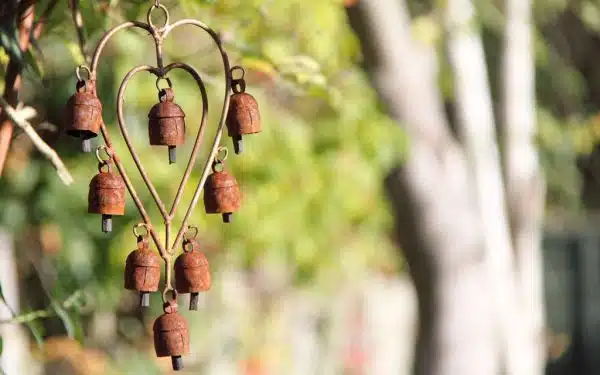Wind chimes are a beautiful and soothing addition to any outdoor space, providing a relaxing ambiance with every gentle breeze. Hanging wind chimes can be a bit tricky, however, requiring some thought and preparation in order to ensure that they are hung safely and effectively. In this article, we will explore the different types of wind chimes available, as well as provide tips and techniques for hanging them in your outdoor space.
When it comes to selecting wind chimes, there are many options to choose from. From bamboo chimes to metal bells, each type of wind chime produces its own unique sound and style. When selecting wind chimes for your space, consider the overall aesthetic you wish to achieve and select accordingly. Once you have chosen your wind chimes, it is important to properly hang them in order to maximize their effectiveness and longevity. By following the simple steps outlined in this article, you can hang your wind chimes with confidence and enjoy their calming effects for years to come.
Benefits Of Hanging Wind Chimes
Wind chimes are an excellent addition to any home or outdoor space. Not only do they produce soothing sounds that can help you relax, but they also add a touch of elegance and charm to your decor. In fact, wind chimes have been used for centuries as relaxation therapy instruments in many cultures around the world.
According to Feng Shui tips, wind chimes can also bring positive energy and good vibes into your home. The gentle movement and pleasant sounds produced by wind chimes can help create a calm and peaceful atmosphere, which is essential for a healthy mind and body. Wind chimes are believed to enhance the flow of positive energy or “qi” in your living space, thereby promoting health, happiness, and prosperity.
In addition to their therapeutic benefits, wind chimes come in various types and designs that cater to different tastes and preferences. From traditional bamboo or metal chimes to modern glass or ceramic ones, there is a vast selection of wind chimes available on the market today. The next section will explore some of these types in more detail so that you can choose the perfect wind chime for your home or garden.
Types Of Wind Chimes
After learning about the benefits of hanging wind chimes, it’s time to explore the different designs and unique sounds they offer. Wind chimes come in a variety of materials, from bamboo to metal, and each produces its distinct sound. Some wind chimes even incorporate natural elements like seashells or crystals.
The size and shape of the wind chime also play a significant role in the sound it produces. Smaller wind chimes tend to create high-pitched tinkling sounds, while larger ones produce deeper, more resonant tones. Additionally, some wind chimes are designed to have a specific musical scale or melody.
When choosing a wind chime for your space, consider not only the design but also where you will hang it. In an open area with lots of wind, a larger wind chime might be appropriate as it can withstand stronger gusts. However, if you plan on placing your wind chime in a more sheltered location such as a covered porch or balcony, a smaller one might be better suited.
- The gentle sound of wind chimes can create a peaceful ambiance in any room.
- A unique design can serve as an art piece that adds character to your home decor.
- Wind chimes make for thoughtful gifts for loved ones or housewarming parties.
- Hanging wind chimes outside can add an enchanting touch to your garden or patio.
With all the different designs and unique sounds available with wind chimes, there is no doubt that you’ll find one that suits your taste and style. Consider the location where you want to place it and how much sound you want it to produce before making your purchase. Choosing the right wind chime for your space will not only enhance its visual appeal but also provide soothing melodies that can help calm your mind after a long day at work.
Choosing The Right Wind Chimes For Your Space
When it comes to adding a touch of charm and elegance to your home decor, nothing beats the soothing sound of wind chimes. With their delicate tinkling sounds and beautiful designs, wind chimes can add a touch of magic to any indoor or outdoor space. Choosing the right wind chimes for your space requires careful consideration of both sound and style.
The first thing to consider when choosing wind chimes is the type of sound you want them to produce. Wind chimes come in a variety of materials, including metal, bamboo, wood, and glass, each producing its unique tone and melody. For example, metal chimes create a sharp, clear sound that is perfect for cutting through outdoor noise while bamboo chimes produce soft, gentle tones that are ideal for creating a peaceful indoor atmosphere.
In addition to the sound itself, it’s essential to consider the style of wind chime that will complement your space. Whether you’re looking for something rustic and organic or sleek and modern, there are plenty of wind chime styles available to suit every taste. When choosing between indoor vs outdoor suitability, it’s important to note that not all wind chimes are designed for outdoor use. Make sure to check the manufacturer’s recommendations before purchasing your new wind chimes.
As you can see, choosing the right wind chimes requires careful consideration of both sound and style. Whether you’re looking for something soothing and relaxing or bold and beautiful, there are plenty of options available to suit every taste. In the next section, we’ll explore the materials needed for hanging your new wind chimes with ease and precision.
Materials Needed For Hanging Wind Chimes
To hang wind chimes, you will need some materials that are readily available at any hardware or home improvement store. These materials include:
- Ceiling hooks: These are screw-in hooks that can be used to attach the wind chime to a ceiling or overhang.
- Chain or wire: This material will allow you to suspend the wind chime from the ceiling hook.
- S-hooks: These small hooks can be used to connect different parts of the wind chime together and create a hanging loop.
- Pliers: You’ll need pliers to bend and shape the wire or chain as needed.
- DIY wind chime hangers: If you’re feeling creative, you can also make your own hangers using materials like seashells, beads, or driftwood.
Once you have all of your materials gathered, it’s time to get creative with your wind chime hanging ideas. Here are five options to consider:
- Hang multiple wind chimes at varying heights for a layered effect.
- Create a mobile by hanging several small wind chimes from a central point.
- Use colorful ribbon or twine to add an extra pop of color and texture to your display.
- Hang your wind chimes in unexpected places like on a fence, tree branch, or even inside a gazebo.
- Experiment with different lengths of chain or wire for a more customized look.
With these materials and ideas in mind, you’ll be able to create a beautiful and unique display of wind chimes in no time. But before you start hanging them up, it’s important to determine the ideal location for your wind chimes based on factors like sound quality and visibility.
Determining The Ideal Location
Choosing the right location for your wind chimes is essential to maximize their benefits. The first factor to consider is the materials that you are going to use in hanging them. It is recommended to choose sturdy and durable materials, such as steel or copper wire, to ensure that your wind chimes won’t fall off easily.
There are several factors that can affect the placement of your wind chimes, including the type of chime and its size, the surroundings, and weather conditions. For instance, if you have a large wind chime with long tubes, it requires more space and should be hung in an open area where it can sway freely. On the other hand, smaller chimes can be hung near windows or entryways where they can catch a breeze easily.
To determine the ideal location for your wind chimes, you should also take into account the direction of the wind and its strength in your area. Wind direction plays a significant role in how well your wind chimes will sound. You should position them in a spot where they will catch prevailing winds from different directions. Moreover, consider checking for any obstructions that may block the flow of air towards your wind chime’s location.
Next step: Checking for wind direction and strength
Checking For Wind Direction And Strength
- When selecting the best location for your wind chimes, it is important to consider the direction and strength of the prevailing winds.
- To determine the direction of the wind, take note of the direction of tree branches or other objects that are being blown by the wind.
- To estimate the strength of the wind, use a wind speed meter or observe the movement of leaves and other objects in the wind.
- Once the direction and strength of the wind have been determined, you can then choose a spot for your wind chimes that will best take advantage of the prevailing winds.
Determining Wind Direction
When it comes to hanging wind chimes, determining wind direction is an important consideration that should not be overlooked. The direction of the wind can impact how often the chimes produce a sound and how loud they will be. It can also affect the longevity of the chime materials.
To determine wind direction, you can observe the movement of leaves or flags in your area. A windsock or anemometer can also be helpful tools. Additionally, if your home has a weather vane, it can provide an accurate indicator of wind direction.
Understanding wind direction is especially important for outdoor decor as it allows you to place your chimes in areas where they will receive optimal airflow and produce pleasant sounds. By hanging them in areas with consistent and strong winds, you can ensure that your chimes will last longer and require less maintenance over time.
Overall, determining wind direction is crucial when it comes to hanging your wind chimes properly. By taking this step, you can enjoy the beauty and calming sounds of your outdoor decor for years to come.
Estimating Wind Strength
After determining wind direction, the next step in wind chime placement is to estimate wind strength. Wind strength affects how often the chimes produce sound and how loud they will be. It also plays a role in the durability of the materials used to make the chimes. Estimating wind strength is important for outdoor decor as it ensures that your chimes will produce sounds that are pleasant to listen to.
To estimate wind strength, you can observe how objects move around your home. For example, if you notice that light objects such as papers or leaves are flying around, it indicates that there is a strong gust of wind. If you see trees swaying heavily or water splashing around in a fountain, it may mean that there is a very strong breeze blowing through your area.
When hanging your chimes, it’s essential to take into account both wind direction and strength. Choosing an area with consistent airflow and strong winds will help ensure that your chimes produce pleasant sounds and last longer over time. By following these simple wind chime installation tips, you can create an outdoor space that not only looks beautiful but sounds beautiful too.
Measuring And Marking The Hanging Point
After checking for wind direction and strength, the next step in hanging wind chimes is measuring and marking the hanging point. Measuring techniques are important to ensure proper placement of wind chimes, as they need to be hung in a location where they can easily catch the breeze and create their signature sounds.
One useful technique is to use a tape measure or ruler to determine the desired height of the wind chimes. This will depend on personal preference, but a good rule of thumb is to hang them at eye level so they can be enjoyed both visually and audibly. Once the height has been determined, mark the spot with a pencil or marker.
Another helpful measuring technique is to consider spacing between multiple wind chimes. If hanging more than one set, it’s important not to overcrowd them as this can muffle their sounds. A general guideline is to space each set at least 3-5 feet apart from each other.
Proper placement is crucial for getting the most out of your wind chimes. They should be hung in an open area that allows for easy movement of air currents, such as near a patio or porch where there is regular foot traffic. In addition, avoid hanging them too close to walls or other objects that may interfere with their sound quality.
When preparing the hook or hanger for your wind chimes, it’s important to choose one that is sturdy enough to support its weight and won’t rust over time. There are various types available including S-hooks, ceiling hooks, and wall hooks, so choose one that best fits your needs and installation location.
Preparing The Hook Or Hanger
When preparing to hang wind chimes, one must first choose an appropriate hanger to ensure the chimes are secure and safe. An ideal hanger should be designed to support the weight of the chimes, be installed in a spot where the wind can carry the chimes’ sound, and be placed out of reach of small children. Once the hanger is chosen, it must be securely fastened to the desired location. This can be done with a hook and eye, S-hook, or other appropriate hardware. Finally, the chimes must be hung on the hanger and adjusted as necessary to ensure they move freely in the breeze. With these steps, the perfect wind chime display can be achieved.
Choose Hanger
When it comes to hanging wind chimes, choosing the right hanger is crucial. There are different styles of hangers available in the market and selecting one that complements your decor is key. You can choose from S-hooks, ceiling hooks, wall hooks, or even plant hangers to hang your wind chimes.
S-hooks are versatile and can be used for various purposes. They come in different sizes and finishes, making them a popular choice for hanging wind chimes. Ceiling hooks are perfect if you want to hang your wind chime indoors. They provide a sturdy base for your chime and do not take up any floor space. Wall hooks are another great option if you want to add a decorative touch to your walls while hanging your chime.
Plant hangers are an excellent choice if you want to add some greenery along with your wind chime. These hangers can hold both plants and wind chimes, giving you a unique decor piece that will surely catch everyone’s attention. Whatever style of hanger you choose, make sure it is strong enough to hold the weight of the wind chime and securely fastened to prevent accidents or damage to your decor.
Secure Hanger
When it comes to hanging wind chimes, choosing the right hanger is essential. Different types of hangers are available in the market, but one crucial aspect to consider is the security of the hanger. A secure hanger ensures that your wind chime stays in place and does not cause any damage or accidents. Therefore, it is important to select a hanger that can hold the weight of your chime without bending or breaking.
Tips for hanging wind chimes in specific locations include ensuring that the hook or hanger is securely fastened to prevent it from falling. For example, if you want to hang your wind chime outside on a tree branch, choose a sturdy branch and ensure that the hook or hanger is tightly secured around it. If you want to hang your wind chime inside, make sure that the ceiling hook or wall hook is screwed into a stud rather than just drywall.
Another tip for securing your hanger is using a locking mechanism such as a carabiner clip or zip tie. This will prevent your wind chime from accidentally falling off its hook due to strong winds or other external factors. By following these tips and selecting a secure hanger for your wind chime, you can ensure that it remains a beautiful addition to your home decor while also providing soothing sounds for relaxation.
Install Hanger
When it comes to hanging wind chimes, selecting the right hanger is crucial. The types of hangers available in the market are plenty, but you should choose one that can bear the weight of your chime without any damage or accidents. However, another essential aspect to consider is preparing the hook or hanger before hanging it. This step ensures that your wind chime stays in place and does not fall off due to strong winds or other external factors.
One way to prepare the hook or hanger is by choosing a sturdy branch or stud where you want to hang your wind chime. Then, screw in a ceiling hook or wall hook tightly around it, ensuring maximum stability. If you prefer DIY hanger ideas, make sure to use sturdy materials like metal wires or chains to avoid any breakage. Additionally, using a locking mechanism such as a carabiner clip or zip tie can further secure your wind chime from accidentally falling off its hook.
Before installing the hanger for your wind chime, it’s important to ensure that it is level and at an appropriate height for maximum enjoyment. You can use a spirit level tool to check if the hook is straight and adjust accordingly. Moreover, consider the location of your wind chime and whether it might interfere with any nearby objects like windows or plants. By following these tips and preparing the hook or hanger correctly before installation, you can enjoy your beautiful wind chime without any worries.
Attaching The Wind Chimes To The Hook Or Hanger
When it comes to attaching wind chimes to a hook or hanger, there are a few things to consider. One of the most important factors is choosing the right hardware. You’ll want to select a hook or hanger that can support the weight of your wind chimes and withstand outdoor conditions, such as rain and wind. Look for options made from durable materials like stainless steel or brass.
Once you have your hook or hanger in place, it’s time to attach your wind chimes. Different knots can be used depending on the type of wind chimes you have. For example, some wind chimes come with a loop at the top that you can simply slip onto your hook or hanger. Others may require more intricate knotting techniques, such as a lark’s head knot or a double half hitch knot.
No matter which method you use to attach your wind chimes, make sure they are secure before letting them dangle in the breeze. With proper attachment and placement, your wind chimes will provide a soothing soundtrack for your outdoor oasis. In the next section, we’ll discuss how to adjust the height and placement of your wind chimes for optimal sound and aesthetics.
Adjusting The Height And Placement
Once you have identified the ideal location for your wind chimes, the next step is to adjust the height and placement. This will determine how well your chimes produce sound and how they complement your decor. One important thing to keep in mind is that wind chimes should not be installed too close to walls or other objects as this can hinder their movement.
Adjusting length is crucial when it comes to hanging wind chimes. The right length will ensure that the tubes hit each other effectively and create gentle, soothing sounds. If you find that your chimes are not producing sound as expected, try adjusting the length by shortening or lengthening it until you achieve a balance between aesthetics and performance.
Finding balance is key when placing wind chimes. You want them to complement your decor while also being functional. Placing them in an area with good airflow will help produce beautiful melodies, but be mindful of surroundings objects that could interfere with their movement. Once you have adjusted the height and placement of your wind chimes, take a few steps back and assess how they look and sound before making any final adjustments.
- Adjust the length of your wind chime until you achieve a balance between aesthetics and performance.
- Avoid installing wind chimes too close to walls or other objects that could hinder their movement.
- Place your wind chime in an area with good airflow while also being mindful of surrounding objects.
Now that you’ve adjusted the height and placement of your wind chime, it’s time to test its sound and make any necessary adjustments. By following these simple steps, you can ensure that your wind chime produces beautiful melodies while also complementing your home decor perfectly.
Testing The Sound And Adjusting As Necessary
To ensure that your wind chimes produce the desired sound, you need to test them. It is vital to hang them in a location where there is enough wind to create a sound. If the chimes are not producing any noise, it might be because they are not receiving sufficient wind or are not positioned correctly. You may want to experiment with different locations before finding the perfect spot.
Once you have found the right location for your wind chimes, it’s time to adjust their sound. The first step is identifying which tubes are out of tune. One way to do this is by tapping each tube gently and listening for any differences in pitch. After identifying the problematic tubes, use pliers or your hands to bend them slightly until they match the rest of the chimes. You may need to repeat this process several times until you achieve the desired result.
While testing and adjusting your wind chimes’ sound can be fun, don’t forget about external factors that can affect their performance. For instance, if it’s too windy outside, the chimes may produce an overbearing sound that could become annoying after a while. On the other hand, if there’s no wind at all, they won’t make any noise at all. Thus, strike a balance between these two extremes by monitoring wind conditions regularly and adjusting as necessary.
As you’ve successfully adjusted your wind chimes’ sound, it’s essential to maintain them properly so they can last longer and perform better over time.
Maintaining Your Wind Chimes
Like a gentle breeze that whispers through the trees, wind chimes add a sweet melody to any outdoor space. Once you’ve hung your new wind chimes, it’s important to maintain them regularly to ensure their longevity and optimal performance. Cleaning frequency and rust prevention are two essential aspects of maintaining your wind chimes.
To prevent rust from forming on your wind chimes, it’s best to hang them in a covered area where they won’t be exposed to harsh weather conditions. However, if your wind chimes do become rusty, you can use steel wool or sandpaper to gently remove the rust. Once the rust is removed, apply a rust inhibitor or spray paint to prevent further corrosion.
Cleaning your wind chimes should be done at least once every few months, depending on how often they are exposed to the elements. To clean them, simply wipe them down with a damp cloth and mild soap. Avoid using abrasive cleaners or harsh chemicals as these can damage the finish. After cleaning, dry them off completely before hanging them back up.
As much as we’d like to keep our homes tidy and organized all the time, things tend to get hectic and busy schedules tend to get in the way. It’s important not to neglect regular maintenance for our beloved possessions such as wind chimes. In the next section, we will explore step-by-step instructions for cleaning and polishing your wind chimes so that they continue producing their beautiful music for years to come.
Cleaning And Polishing
Now that you know how to maintain your wind chimes, it’s time to learn how to clean and polish them. The first step is to gather all the necessary materials for a DIY cleaning. You will need a soft cloth, mild soap, warm water, and white vinegar. Avoid using abrasive cleaners or chemicals that may damage the finish of your wind chimes.
To clean your wind chimes, start by wiping down each tube with a damp cloth. Then, mix a solution of warm water and mild soap in a bowl. Dip the cloth into the solution and gently rub each tube until all dirt and grime are removed. For hard-to-reach areas, use a toothbrush or cotton swab. Once you’re done cleaning, rinse your wind chimes with warm water and dry them thoroughly with a clean cloth.
If you prefer professional polishing services instead of DIY cleaning, seek out an expert who specializes in restoring metal items such as wind chimes. A professional polisher can remove scratches and restore luster to your wind chimes without damaging them. Just be sure to research their credentials before entrusting them with your precious possessions.
As important as it is to keep your wind chimes clean and polished, storing them properly is equally crucial. In our next section, we’ll discuss the best ways to store your wind chimes when not in use so they remain beautiful for years to come.
Storing Your Wind Chimes
Once the wind chime season is over, it’s important to store your chimes properly. Proper storage solutions will help keep your wind chimes in good condition for years to come. Ideally, you should store them indoors in a dry place, away from direct sunlight. If that’s not possible, cover them with a tarp or heavy plastic sheeting.
When storing your wind chimes, it’s important to take proper maintenance tips into consideration. Before storing them, clean the tubes and wooden elements of dust and debris with a soft cloth. Once they’re clean and dry, apply a thin layer of oil to the metal parts to prevent rusting. For wooden elements, apply wood conditioner or wax to maintain their appearance.
Whether you’re storing your wind chimes for the winter months or just putting them away for a while, taking care of them will ensure they last longer and remain in good condition. By following these storage solutions and proper maintenance tips, you can enjoy the soothing sounds of your wind chimes for many seasons to come. However, if you do encounter any issues with your wind chimes after storage or during use, there are some common troubleshooting methods that can help resolve those problems.
Troubleshooting Common Issues
After storing your wind chimes, the next step is to hang them in an appropriate location. Wind chimes can add a calming atmosphere to any outdoor space, but it’s important to hang them properly to ensure they are not damaged by weather or other factors.
The first step is to choose a location that is sheltered from strong winds and direct sunlight. Hanging your wind chimes on a porch or under a tree can be a great option. It’s also important to make sure they are hung where they won’t be disturbed by people or pets.
Once you have chosen the perfect location for your wind chimes, it’s time to hang them up. Follow these steps for optimal results:
- Choose a sturdy hook or hanger that can support the weight of your wind chimes.
- Use a level to make sure the hook is straight before hanging your wind chimes.
- Hang the wind chimes from the hook using the provided chain or string.
- Adjust the height of the wind chimes so they don’t touch anything when they move in the breeze.
- Give them a gentle tap to make sure they are securely attached and create beautiful music.
By following these steps, you can enjoy the soothing sounds of your wind chimes without any issues. However, if you do encounter any problems such as tangled strings or broken pieces, there are common solutions and troubleshooting techniques that can help fix these issues.
Conclusion
Wind chimes are not only beautiful to look at, but they also bring a sense of peace and tranquility to any space. Hanging wind chimes is easy and can be done in just a few simple steps. Before you begin, it’s important to determine the ideal location for your wind chimes and choose the right type for your space.
There are many benefits to hanging wind chimes, including reducing stress levels and providing a calming atmosphere. With so many types of wind chimes available, it’s important to choose one that fits your personal style and complements your decor. Once you’ve selected the perfect wind chime, gather the necessary materials and determine where you will hang it.
To maintain your wind chimes, regularly clean and polish them to keep them looking their best. When it’s time to store your wind chimes, make sure they are properly wrapped and stored in a safe place. If you encounter any issues with your wind chimes, troubleshooting common problems can help ensure they continue to provide a soothing sound for years to come.
Incorporating wind chimes into your home decor can add an element of whimsy and relaxation. Take the time to choose the right type of wind chime for your space and hang it in an ideal location. By maintaining and storing your wind chimes properly, you’ll be able to enjoy their calming sound for years to come.
Image Credits
- “Wind Chime” by Sprogz (featured)





























